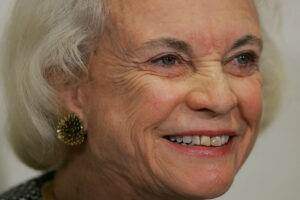'The First': Sandra Day O'Connor Finally Gets Her Own Documentary Treatment
Get to know the first woman to ever serve on the Supreme Court.

Justice Sandra Day O’Connor (Photo by Win McNamee/Getty Images)
What’s one word that you’d use to describe Justice Sandra Day O’Connor? Some would call her a trailblazer, some would call her a pioneer, but most would simply refer to her as first.
That’s exactly what the documentary “Sandra Day O’Connor: The First” focuses on in its early moments, with a clip of Justice O’Connor speaking about the sheer intensity of her experience as the first woman to be appointed to the Supreme Court of the United States in nearly 200 years. Justice O’Connor was no fan of the press scrutiny she was subjected to because of her appointment’s historic meaning, saying of her time on the Court, “Let’s move on and let’s let the work be done. It didn’t seem to work that way because everywhere that Sandra went the press was sure to go.” Before America’s obsession with the Notorious RBG, there was a media obsession with SDOC.

Early Adopters Of Legal AI Gaining Competitive Edge In Marketplace
Based on the book, First: Sandra Day O’Connor (affiliate link) by Evan Thomas, the film follows Justice O’Connor from her childhood to her final days on the Supreme Court, marking her inspirational accomplishments along the way as she shaped American jurisprudence. Check out a trailer for the film, below:
Born in 1930 in El Paso, Texas, Justice O’Connor grew up in Arizona, and in her youth, she started on a path to excellence, skipping two grades before she went on to Stanford, later graduating from the elite university’s law school (alongside her hopeful love interest and future colleague on the Supreme Court, William H. Rehnquist). After graduating, she couldn’t get an interview at a single law firm because she was a woman, but she contended that she “didn’t go to law school to become a wife,” so she forced her way into the legal profession, then-current societal norms be damned.
By the time she was nominated for a seat on the Supreme Court by President Ronald Reagan — perhaps to make up for his opposition to both the Equal Rights Amendment and abortion — Justice O’Connor was a well-regarded state judge. Because she was the first woman to be considered for a seat on the nation’s highest court, there were more requests for press passes for her confirmation than there were for the Watergate hearings. She was confirmed on an unanimous 99-0 Senate vote — something that seems unheard of considering today’s political climate.
Sponsored

Early Adopters Of Legal AI Gaining Competitive Edge In Marketplace

Legal AI: 3 Steps Law Firms Should Take Now

The Business Case For AI At Your Law Firm


The Business Case For AI At Your Law Firm

Justice O’Connor received no special treatment on the Supreme Court, from her colleagues or from the lawyers who appeared before her. When asking her first question during oral arguments, an attorney interrupted her and said, “Let me finish.” Behavior like this would be unimaginable in today’s world, but in those times, Justice O’Connor knew that she needed to “disagree agreeably” — after all, as she noted time and again throughout her career, “It’s good to be first, but you don’t want to be last.”
Justice O’Connor eventually started leaning left, becoming the high court’s critical swing vote on issues like sex discrimination, abortion rights, gay rights, and affirmative action. Finally, after 12 years as the only woman on the bench, she found true joy and a contemporary when Justice Ruth Bader Ginsburg was confirmed as the second woman to ever serve on the Supreme Court (and a women’s bathroom was finally built for the pair to use).
She decided to step back from the Court in 2005, when her husband’s Alzheimer’s diagnosis entered a more difficult phase. Justice O’Connor was incredibly disillusioned by her successor, Justice Samuel Alito, a man who she viewed as a “betrayal of all her accomplishments.” In her retirement, she served at he helm of iCivics, a program to teach government and civics lessons to middle and high school students. “The First” doesn’t touch upon Justice O’Connor’s 2018 dementia diagnosis, and her decision to step away from public life.
Executive producer Cameo George said this of the film’s fascinating subject:
As the first woman appointed to the Supreme Court, Sandra Day O’Connor was meant to be a symbol. However, once on the bench, she often defied expectations and was able to use her vote to significantly influence the direction of the Court and our country for nearly 25 years.
Sponsored

Navigating Financial Success by Avoiding Common Pitfalls and Maximizing Firm Performance

Is The Future Of Law Distributed? Lessons From The Tech Adoption Curve
“Sandra Day O’Connor: The First” premieres tonight at 9:00-11:00 p.m. ET on AMERICAN EXPERIENCE on PBS, PBS.org, and the PBS Video app.
 Staci Zaretsky is a senior editor at Above the Law, where she’s worked since 2011. She’d love to hear from you, so please feel free to email her with any tips, questions, comments, or critiques. You can follow her on Twitter or connect with her on LinkedIn.
Staci Zaretsky is a senior editor at Above the Law, where she’s worked since 2011. She’d love to hear from you, so please feel free to email her with any tips, questions, comments, or critiques. You can follow her on Twitter or connect with her on LinkedIn.







